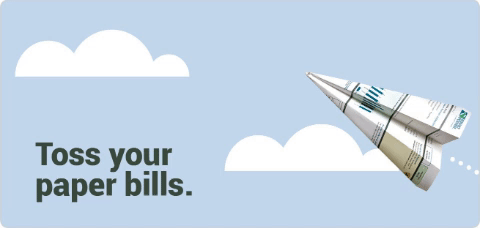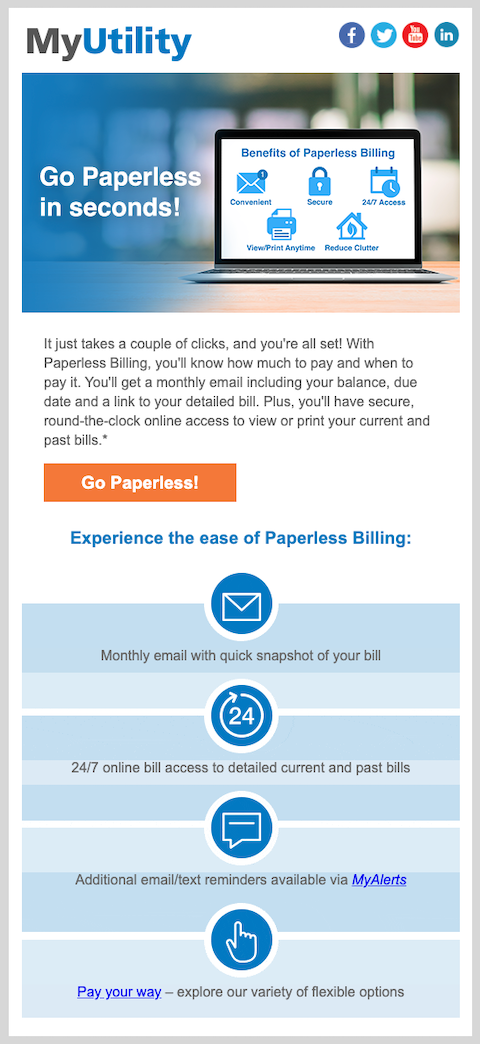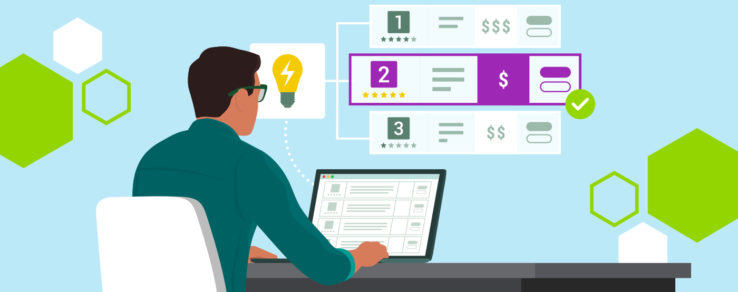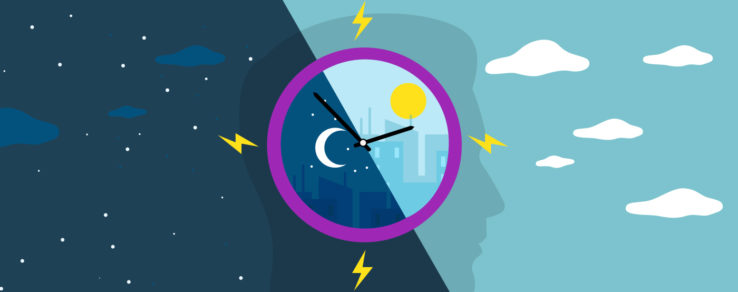It can be hard to believe that there are still customers left to enroll in paperless billing. After all, with the tremendous growth of electronic billing, automatic payments, mobile apps and digital currency, most customers now prefer a paperless way of paying utilities.
However, some customers remain reluctant to adopt paperless utility bills. Habits can be hard to break — and many customers are accustomed to receiving a paper bill in the mail. Energy utilities are faced with the challenge of converting resistant customers who may not realize the many benefits of going paperless.
“When I think of who is left to enroll in paperless billing, two categories of customers come to mind,” says Melissa Thom, Brand Engagement Lead at Idaho Power. “One group is those who don’t regularly engage with us and haven’t considered whether we have a paperless option or not. The other group is older generations who have a set routine for paying their bills, and that usually involves paper.”
For utilities, developing a plan of action to encourage these customers to enroll in e-billing programs and finally go paperless can make all the difference.
Prioritize Proactive Outreach to Utility Customers
The latest research finds that customers spend only eight minutes per year interacting online with their utility, and only six minutes per year thinking about their energy bill. According to Thom, encouraging a paperless way of paying utilities starts with proactive outreach and ongoing digital communications.
“If customers are not thinking about Idaho Power, they’re also not actively looking at ways to enroll in our programs,” Thom says. “That’s why we do proactive outreach on programs like paperless billing, auto pay and budget pay for customers who haven’t needed to think about us in a while.”
To boost program enrollments, Idaho Power recently revamped its My Account portal. When customers log in, they now see a list of programs with either a red “X” or green check mark by each one. This indicates whether or not they have enrolled in the programs.
“On a behavioral level, we think customers will want to see all green check marks, pushing them to enroll in paperless billing and other programs,” Thom explains. “This also makes the enrollment process much easier since they are already logged into their account.”

My Account pop-up ads are another marketing tactic that has been effective for Idaho Power. The pop-up ads highlight the benefits of paperless utility bills, including more convenience and greater security. When customers click on an ad, it will take them directly to the paperless billing enrollment page.
Educate Customers on the Benefits of Paperless Utility Bills
It’s important to explain the benefits of e-billing, including faster payments, easier access to online payment options, and reducing clutter in customers’ homes. These benefits should be presented clearly and concisely in email campaigns, website landing pages and other communications.
One of the biggest benefits of paperless utility bills is the ability to pay anytime and anywhere. An e-bill marketing campaign from a Pennsylvania-based energy utility focused on how e-bill was a must-have for summertime. Customers have the opportunity to pay their bill “from across the nation to around the world.”

Feedback from customers who have resisted a paperless way of paying utilities can also be useful. Utility marketers should identify the common objections or concerns customers have about paperless billing and address them in future marketing campaigns.
For example, many customers have concerns about the security and privacy of their personal information when making digital payments. Ease customer concerns by emphasizing how they can access their bills through secure portals, reducing the risk of personal information being compromised in the mail. In addition, encryption technology adds extra security measures to protect customer information.
Discover the Impact of e-Bill Incentives
Offering incentives can be the push that resistant customers need to make the switch. This might include discounts on monthly bills, cash back or small rewards like $5 Amazon gift cards.
There is no one-size-fits-all incentive that works across all utilities. For example, in a city with a large percentage of sports fans, customers may be motivated by the offer of tickets to the big game. Cities with a focus on the great outdoors may be motivated by environmentally minded giveaways like energy-efficient appliances.
PSEG Long Island took advantage of various incentives to encourage a paperless way of paying utilities, including a chance for 10 winners to receive $1,000 each. The utility also tried smaller incentives like free LED light bulbs.

Through testing of numerous incentives, PSEG Long Island identified what worked best for their target audience and successfully increased paperless billing enrollment by 51,000 customers. The energy utility discovered that tangible, guaranteed incentives drove greater engagement.
Idaho Power utilized a sweepstakes to encourage customers to enroll in paperless utility bills. Customers who enrolled in paperless billing were automatically entered into a drawing to win an iPad Mini. According to Thom, it made sense to offer a digital prize for a campaign encouraging customers to switch from paper to digital bills.

During the sweepstakes, 38,000 customers logged into My Account and were shown the pop-up ad. With a click-through rate of 3%, around 1,100 customers clicked through to the paperless billing enrollment page.
Make the Paperless Enrollment Process Easy
Oftentimes, a complicated enrollment process is the main barrier preventing customers from signing up for paperless utility bills. Providing simple and straightforward instructions can go a long way in encouraging customers to switch.
Make enrollment easy by reducing the number of steps needed and providing multiple ways to enroll, including online, through the utility mobile app and via text message. The more clicks involved in enrollment, the more likely customers will navigate away from the page out of frustration.
A fast enrollment process was the focus of this email from a large Northeast energy utility. With just a few clicks, customers could go paperless in seconds.

Utilities should also provide paperless sign-up directly through their mobile app. Customers who download the app are more likely to be tech-savvy and prefer a paperless way of paying utilities. This is also an ideal channel to promote the benefits of paperless billing.
“We promote a lot of programs together, like paperless billing, auto pay and the mobile app, because we think if customers enroll in one, they are likely to enroll in another,” Thom says. “If they’re engaged in My Account or the mobile app, it’s much more convenient for them to enroll in paperless billing.”
Reach the Next Generation with e-Bill Promotions
Every day, younger generations are becoming the next wave of utility customers. While Gen Z are more likely to show interest in paperless utility bills, they aren’t keen on paying with traditional methods like debit cards and online banking.
Gen Z customers prefer paying with new money management tools like apps and digital wallets. Research also finds that less than 50% of Gen Z customers have traditional bank accounts. In the coming years, energy utilities will need to think about how paperless billing will evolve to meet Gen Z’s preferences.
Idaho Power will soon be expanding its payment options, as a growing number of customers prefer paying with mobile payment services like Apple Pay.
“We will soon have more digital payment options, including Apple Pay, Google Pay and PayPal in the very near future,” Thom says. “If a customer loves using Google Pay anywhere they go, they should be able to pay their energy bill in the same way. We have to constantly be thinking about the preferences of younger generations.”
Reach Remaining Customers with Paperless Ways of Paying Utilities
For energy utilities, there will always be customers to enroll in paperless utility bills, whether brand-new customers or those finally ready to make a change. According to one study, three in four adults across all ages would likely switch at least one bill to paperless. In fact, 87% of millennials were likely to pay at least one bill digitally.
“I look at paperless billing two-fold,” Thom says. “If most of our customers know that it’s an option for them, I’m happy. I’m never going to force any customers into the program. I just want them to know their options — that’s the awareness side of marketing paperless billing. Then there’s the conversion side — sometimes all customers need is an extra little push to make the switch.”





